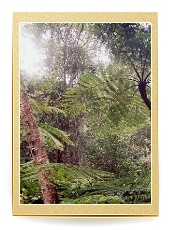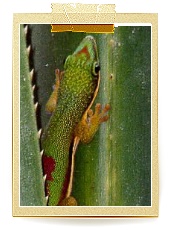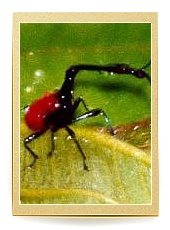Where can you hear the Indri?
Next morning (quite early for me – at 7 am), having said goodbye to the Oblates and to Marek, I hopped on my bike and headed east. I wanted to cover a distance of 140 km, knowing that it would not be a piece of cake. Although Antananarivo is situated on a plateau sloping eastwards, that day was full of inclines too, so at the end of the day the many kilometres I had travelled did affect my legs, and other body parts as well. When I got to the intended overnight accommodation, I was 'a bit' washed-out, especially after spending the whole day in blazing sun, exposed to a temperature of 40 degrees. After 9 hours of cycling I found a hotel – the most expensive I came across in Madagascar. It cost me FMG 68,000 per night, but I decided to spend two nights there in order to visit the d'Andasibe - Mantadia National Park. I had to buy a three-day ticket anyway, so I could spend an extra day strolling around the Park, even though – as you might expect – a cyclist always wants to go back on the track!
In the evening I wanted to have dinner, but the prices were exorbitant! Almost all restaurants, bars and hotels are run by the Chinese or Pakistani. They know that the place attracts many foreigners – this is the argument for driving prices up to a certain level. And thus you can meet people from Australia, France, Great Britain, Canada… Some of them carried along truly breathtaking photo equipment. In the end, intent on saving an equivalent of USD 5, I only ate a sandwich and went to sleep slightly hungry. Next morning I bought some local baked goods and, being already very hungry, I devoured everything at once. Although I am not a typical Poznań dweller – fixated on saving money – I did not feel like paying for overpriced products, nor could I afford it. I have already mentioned my financial difficulties – I had ca. USD 800 available for the journey, hoping that it would be enough. I did not think it proper to spend the money too carelessly.
At 7 am sharp I was at the park gate, waiting for a guide to hire. Entrance ticket cost FMG 50,000. Hiring a guide (for another FMG 60,000) was a must – not just to avoid getting lost in the maze of footpaths, but also because he knew how to find lemurs, he could show me what really was worth seeing, and could easily name all the things I found interesting. Besides, tour guides are the only people on the island who speak English. Park visitors can select one of several routes. Although my batteries were a bit flat, I chose the longest one – the Grand Course – lasting 5 hours. I must admit I was surprised to see what the bush looked like: a tangle of trees, lianas, tree ferns, and an abundance of other plants.

I also saw several orchid species there. I was left alone for a moment, when the guide was looking for lemurs. We met a whole family, with a newborn baby lemur. They were the Indris – the largest of the Malagasy lemurs, weighing up to 7 kilos. Unfortunately they were sitting high up in the trees. After some time, however, they came down – or rather jumped down – to sit on lower branches, giving me a chance to take some photos. I had a Canon EOS 50E at my disposal with a 28-200 mm lens, which proved extremely useful during my expedition. Still, in situations like the one described above, a 400 mm telephoto lens (preferably a 100-400 mm zoom) would have been much better. For taking shots of nature, a 90 mm macro lens would have surely come in handy. Unfortunately, when undertaking the journey whose main goal was different than photography, I could not afford to carry such equipment along – it weighs too much. My legs could literally feel each kilogram of the luggage!

The Park prides itself on many endemic specimens (i.e. ones that can be found nowhere else in the world). The guide showed me several types of 3-cm frogs, some of them with beautiful colours. In the case of one species, the male was red while the female was green with red spots. Another curiosity was an incredible spider with a rhombus-shaped abdomen, its width being 4 times greater than its length. Madagascar is also home to about 1000 species of orchids, which I have mentioned above. I managed to photograph an amazing beetle with a body resembling a giraffe.

The male has a sizeable neck, its length being more or less the same as the abdomen. Moreover, you can spot a bird of paradise or, when crossing the park at night, a magnificent kingfisher. The bird sleeps soundly on a tree branch, paying no attention to flash lights. Also chameleons are easiest to see at night when their protective colouration subsides, leaving the animal monochrome: light green or brown. I had a chance to see two chameleons: one was 40 cm long, and the other measured no more than 5 cm, and that was the size of an adult specimen. The largest of the 150 species of chameleons living in Madagascar is 60 cm long, while the smallest is 3 cm, being – just like other Brookesia chameleons – a ground-dwelling species. They sleep at the ends of branches, thus protecting themselves from being attacked by snakes. Contrary to the common belief, rather than changing their colour in order to blend into the surroundings, chameleons express their emotions in this way. When two males are fighting for a female, a full range of colours can be observed, spanning from green, yellow-and-red, blue and brown even to black, in the case of the defeated rival! What is interesting, while catching an insect a chameleon can shoot out its tongue at a distance almost equalling the length of its body, in just 0.04 of a second!
It is always useful to have a head torch during such night excursions, as it ensures the freedom of movement and hassle-free operation of a camera or camcorder. I also found this gadget helpful when cycling at night. When I was in Madagascar – in October and November – the Sun set at 5 pm, the day quickly turning into night.



